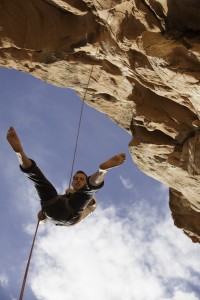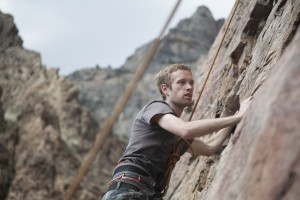BYU students are taking advantage of the Utah landscape by making the climb from traditional summer activities to more extreme recreational sports.

Rock climbing, whether for sport, recreation, an adrenaline rush or a date idea, is an activity that is perfect for BYU students. Dry Canyon, Maple Canyon and Rock Canyon are all within a 20-minute drive from campus.
In fact, the great location of BYU as well as students’ adventurous nature makes it surprising that there isn’t a rock climbing club at the university.
Chris Stopa, a sophomore majoring in biology and a regular climber, said, “I’ve thought about starting a club here at BYU, but we go with groups of people so often that it is almost like we are an unofficial club anyway.”
Stopa started to become serious about the sport after taking climbing classes and teaching himself online,.
“I’ve always been an oudoor enthusiast, and rock climbing was just the next step up,” Stopa said. “It is a greater challenge and more thrilling than most other sports. When you climb a mountain, you get to look down and say, ‘Wow. I did that.'”
The view is beautiful, but there are more benefits to climbing. Improved cardiovascular health, increased muscle tone, flexibility, mental health and even weight loss are just a few of the overall health benefits of climbing.
Mike McKell, a junior and history major thrives on these benefits, “It is so fun being up there and figuring out where to put your hands or the next move of your foot as you climb. it is physically as well as mentally demanding, which is what makes it fun.”
McKell got into climbing roughly seven months ago after taking a rock climbing class at BYU. Ha has since gotten serious about the sport and has kept it fun and interesting, mentioning that he and his friends try different types of climbing, including top-repelling off cliffs, arches and waterfalls in the nearby canyons.

Some other main types of climbing include:
- Traditional climbing: Also known as trad, involves routes that do not have permanent anchors. This type of climbing is seen as more dangerous because climbers place anchors in the route as they ascend.
- Sport climbing: Unlike traditional climbing, sport climbing uses the protection of permanent anchors.
- Bouldering: This type of climbing is done usually within 20 feet of the ground without the use of ropes. Bouldering is meant to test upper body strength and endurance.
- Deep water soloing: This type of climbing is done over a deep body of water and without a rope or a partner. Soloing is dangerous, but the water below creates a safety net in case a climber falls.
- Mountaineering/canyoneering: In essence, it is the sport of climbing full mountains or canyons and is a more elaborate and challenging form of hiking.
From the snow-capped mountains of northern Utah to the red rock formations in southern parts of the state, climbers flock to Utah to enjoy the different types of climbing on the different terrains.
Willis Knapp, a recreation management graduate and manager at the climbing gym The Quarry, said, “Some of the biggest climbing companies are moving to Salt Lake due to the proximity of the mountains and the options that that creates for climbers.”
He said more BYU students should take advantage of living in this “mecca,” noting that The Quarry is open for climbing until midnight.




